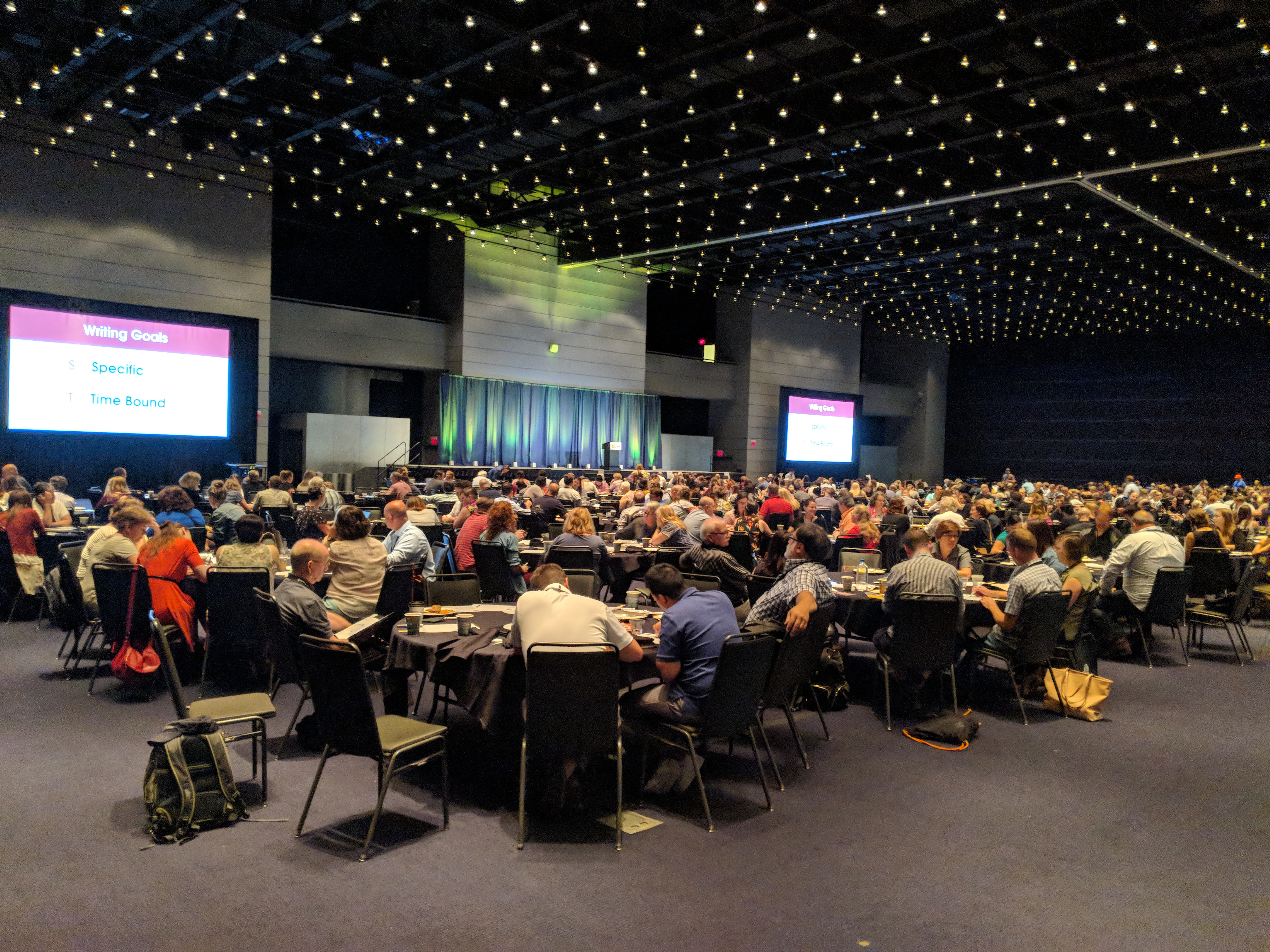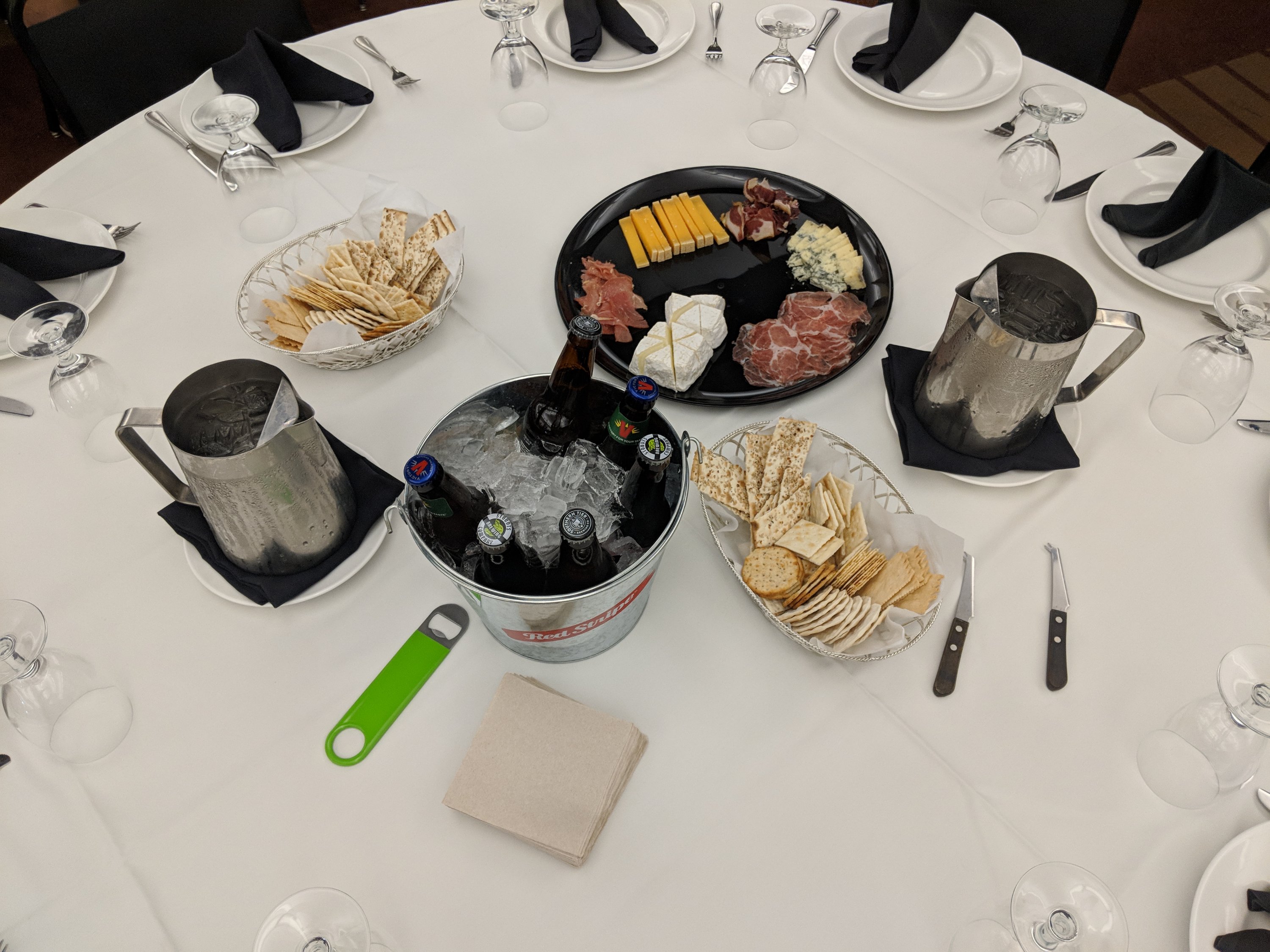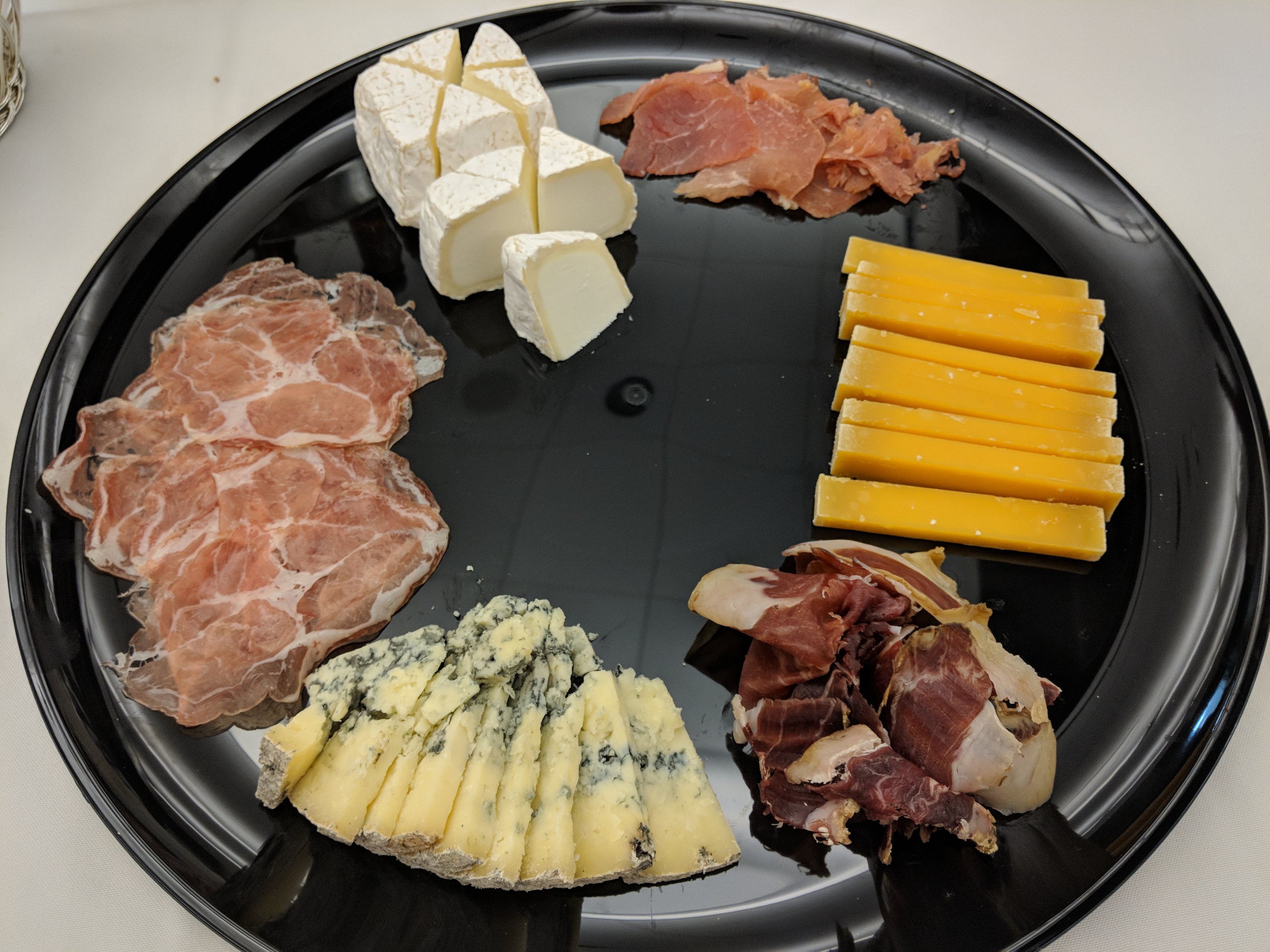Maine is in the house!

One winner from the Pine Tree State this year– Congratulations:
Winter Hill Farm, 3rd Place for their Feta!

Maine is in the house!

One winner from the Pine Tree State this year– Congratulations:
Winter Hill Farm, 3rd Place for their Feta!


Our day began early, as it often does on Fridays, with a meeting of the Guild Leaders for breakfast. And right off there was a major success! Arlene had written to the ACS asking that there be some programming at the conference addressing the ongoing Dairy Crisis for both organic and conventional producers of fluid milk. At the meeting ACS Executive Director Nora Weiser announced that a previously scheduled presentation had to be canceled and that the ACS wanted to replace it with a networking forum on the issues around the Dairy Crisis. So important, and big thanks to Arlene for pushing that forward!
Nora updated the Guilds on the highlights of the topics that has been on the agenda to discuss with the FDA. Douglas Stearn from FDA would be updating the entire conference at lunch with a presentation, but she wanted to let us know:
Nora also announced that ACS was beginning the work on developing a Certified Cheese Maker exam, beginning with the established exam that Wisconsin currently uses.
It was great to see all our fellow Guilders, if only early on a Friday morning once a year. One other items brought up is that ACS helped to fund a website to promote communication and discussion among different Guilds year-round. Although it was launched last September there was still limited engagement with the website among more than one Guild (Maine!) but at the meeting the Guilders expressed a renewed interest in engaging in and using this tool.
And with that we had already gone 30 minutes over our scheduled time, but as Nora pointed out we almost always do, and she promised that next year she would build that in!

The Fight for Diversity in Food
Gordon Edgar, Rainbow Grocery Cooperative (Portland, OR)
Bronwen Percival, Neal’s Yard Dairy (UK)
Francis Percival, The World of Fine Wine
Simran Sethi, Journalist and Educator
A large crowd filled the meeting room where this panel discussion took place including some very big names in the cheese world to hear more details on what is clearly a very hot topic. And oh, my, what an exciting, important, and at times difficult conversation was had. This is the kind of session that really makes the trip to ACS worth the time and money.
If you don’t already recognize the Percivals names, they co-wrote the important new book on the history and future of a cheese industry focused on quality rather than quantity – Reinventing the Wheel. In that book they refer to an ideal kind of cheese as “Real Cheese.” That judgemental label would normally be controversial when speaking to a room full of cheese makers, mongers, and other industry professionals. It actually refers to a UK campaign to bring back “Real Ale” to British pubs. That campaign pushed back against the dominance of global common-denominator beers that had a stranglehold in British pubs for too long. Luckily in the US it didn’t take a public campaign to reverse the tide of flavorless industrial beer, it just took an increasing number of Craft Beer makers and consumers who sought out new and different beers (see Day 1 summary of the Fermentation Revolution for more detail!).
We’re all familiar with the “Artisanal Food” idea and claim, however they made the point that there is no true ‘certification’ of what “Artisanal” means. Therefore the term means whatever the person saying it wants it to mean, and therefore it is ripe for co-option by industrial food producers. It’s pretty clear that there’s a good chance small food producers will lose the ability to meaningfully use the term in the future. So when/if that happens where do we go?
Francis jumped right in to start the conversation by saying that he felt “Farmhouse” cheese better defined what he considered Real Cheese, and that Real Cheese was subversive at every level. By “Farmhouse” he indicated that Real Cheese is made with the cheese maker and the herdsman have a symbiotic relationship: the cheesemaker can tell the the herdsman how to change the way the barn is run, or visa versa. Simran asked what he meant by “subversive” because that’s not always a positive quality? He explained that at every step of the way the production of Real Cheese challenged the conventions of “conventional” farming practices, whether it was with the ideal forage, the best breed of dairy animal for each cheese type, and then the active encouragement of a *more* diverse microbial environment during the make process and into the aging cave, all the way through to the retail experience. “Let’s face it, cheese is an awkward thing to manage on a sales counter, as well as through all the steps it took to get there.” Another way he likes to define Real Cheese is as “the flavors of good farming.”
Bronwen added that she felt the cheesemaker’s role was to take the highest quality milk that they can find, execute a technically sound curd, and then step out of the way and let the quality of the milk that went into the cheese “shine through.” “What’s really exciting today is that the science is now able to test and validate the idea that better milk makes better cheese….Science is also debunking the conflation of milk quality with milk sterility. In fact cheese is perfect microcosm of the evolving thoughts on microbes and microbial communities.”
Simran expanded the idea of the challenges of creating Real Cheese from the milk quality itself to the labor aspect as well. Low wages have led to a lack of skilled dairy laborers which has moved many dairy farmers to look seriously at robot milking machines. Bronwen said that the important point of this story is not that the robots mis-handle the cows – on the contrary, they are well engineered to make the cows as comfortable as possible – but that the robot milkers are optimized for the production of liquid milk that is intended to be pasteurized (and chilled immediately). If the robot milker becomes more common that would reduce the opportunities for cheese makers to access milk in the specific way that they would like to receive it.
This was followed by an exchange among all the panelists about how hard it is to actually produce good quality milk for cheese making and that this work was often lost on the consumer. To counter this Bronwen pointed to Nick Millard the herdsman at Haford Cheese, the UK’s oldest organic dairy, who has become an Instagram star by illustrating the work that he does every day.
The problem, Francis said, was that of information asymmetry: we [the conference goers] know how much farmers work and what it costs to make good milk. The problem is that the customers do not know this, so all they see is the price of the resulting cheese. He pointed to the classic economics paper by George Akelof called The Market For Lemons, which focused on the used car market in the 1970s, and it proved that MORE information for the consumer increased the size of the market.
That said, Francis continued, it’s a very difficult ask of retailers to go into deep detail about why one specific cheese they sell is unique because the danger is that the parallel message the customer received is that all the other cheeses being offered are flawed in some way. Gordon said that this was true, but that a good retailer knew how to walk that line between featuring a cheese and denigrating others. He encouraged cheese mongers to “keep pushing the envelope with consumers” by walking them just a little farther down the education path each time you see them at the shop.
There is another danger, Simran pointed out: “We want to valorize but NOT fetishize the work!” Bronwen quipped: “Right, because it turns out pain tastes really really good!”
Gordon pointed out that the “Factory Farm” concept was developed in an attempt to counteract one of the Great Agrarian Myths: Self-Sufficiency. The first cheese factories were built as a way to relieve the “farmers wife” of the additional task of making cheese after the farmer had done all the work to milk the cows, not to mention grow the food to feed the cows. In many of the Agricultural reports in the late 1800s there is a regular plea to “free the farm wife of the burden of cheese making!” It was really successful model, but extended now 150 years that same model is now about to move to relieving the farm of the farmers…
At this point Francis and Bronwen wanted to make sure people understood that despite their illustrations of the benefits to Real Cheese of many of the old and “inefficient” methods of cheese making, that their counter mantra is to “Optimize without Compromise.” Francis told the story of a Loire goat cheese maker they visited that was making the most perfect old fashioned aged goat cheese logs that seemed to be the result of hundreds of years and many generations of perfecting the process. But when he asked the cheese maker about the years and generations of experience that went into their product, they laughed and said I used to be a bookkeeper and I wanted a change of pace, so I bought this business and the equipment four years ago then learned how to do it… Their advantage, Francis said, was that in the Loire there was a wealth of resources (refrigeration, equipment, herd management, etc.) devoted to chevre makers. That made it easy for a newcomer to achieve an optimized process quickly. It’s the cheese maker that has to “reinvent the wheel” at every step of the process, and has few options to access skilled resources who understand the business, and has to work with sub-optimal equipment who experience the “pain” we just talked about. However, THIS was where state and local governments could step in and invest in growing a specific industry (in this case cheese making and its ancillary businesses) without picking winners.
After all, a cheese maker can’t just do the work for love. The work has to be profitable and sustainable. She also said that in her historic research she found the prices of the new American factory cheese that was being exported for Britain where it could be sold for half the prices of Somerset Farmhouse cheddar in London. In today’s dollars, that “cut rate” cheese costs $75/lb. So although price pressure is a real factor in today’s marketplace, there’s something wrong when factory cheese is selling for 15x less…
From the cheese monger’s perspective, Gordon encouraged the retailers in the audience to commit to on expensive cheese for six months or a year in their shop, introducing as many of their regular customers to it as possible. “It won’t necessarily make you money, but it will do a good thing…and there are many stories about the difficult-to-sell cheese of today becoming the must-have cheese that is difficult to keep in stock tomorrow.
And with that Simran opened the floor to the audience.
One person asked Gordon or Bronwen if they knew of any mongers that organized their cases thematically in a way to identify a group of cheeses that had similar production philosophies. Neither of them offered an example, but Francis claimed that Bronwen was being too modest: at the Neals Yard Dairy shops the mongers often created a thematic structure to the display cases that weren’t always obvious to the buyer, giving those mongers an opportunity to dive a bit deeper into what cheeses they carried and why they were arranged that way. That said there are still no actual certification programs that can guarantee a product to be made exactly the way it’s described (in many cases).
When asked how the idea of diverse cheese being sold at its true cost squared up with the idea of the local cheese maker selling into local markets? Frances thought that instead of the primary focus being on the local supplier, that “good distribution makes good cheese” and that for a cheese maker to improve what they make they must, by necessity, “need to play against the Big Boys” in a global competition. However he was challenged by a dairy farmer who said that “the very people who care the most about diversity in cheese don’t actually care about competing world-wide.”
Another audience member asked how a focus on biodiversity in cheeses can square with the parallel focus on food safety? Bronwen pointed out that it is now very different in the industry than it had been even ten or twenty years ago, because “science is on our side!” Science is proving that cheeses made with a focus on biodiversity are being made safely. At the same time the fundamental question becomes what is the acceptable risk in eating any cheese, but particularly biodiverse cheese made from raw milk? If the answer is that no risk is acceptable then we’re lost. Because, as we see in the news all the time, NO food is without risk, including any kind of cheese. If we can quantify the risk of eating cheese, and then use science to reduce that risk to an agreed upon acceptable level, then we can have Safe Cheese that is Biodiverse.
Another audience member stood up to challenge the idea of “Farmhouse” cheese being the ONLY type of cheese that can be considered “Real Cheese” making the point that there are many cheeses made by cheese makers who do not produce their own milk, and yet have a limited or even single herd source for that milk, as well as a business relationship with that dairy farmer. Frances admitted that in France they do break up their classification system into “fermier” (Farmhouse), “artisanale” (small producer that buys in milk), “cooperative” (dairy with local milk supply that may come from multiple farms), and then “industriel.” He admitted that his idea of “Farmhouse” only is extreme, but on the other hand it’s the only label that’s externally verifiable. A small producer’s milk supply is only as good as the contract they’ve signed promising to purchase the milk, and those contracts can vary and are not always transparent to the consumer.
And then they had to end the discussion. Nothing was solved, but a lot was said about a subject that everyone clearly cares a lot about and continues to struggle with.
Afternoon session:
Large Farms can have Quality Milk, Healthy Animals, and Cow Comfort
Kim Bremmer, AG Inspirations
George Crave, Crave Brothers Farmstead Cheese
Brian Fiscalini, Fiscalini Cheese
Modarator: Kari Skibbie, Dairy Farmers of Wisconsin
This was an interesting session, but mostly because it was quite defensive in its attempt to equate two farms with herds of over 2000 cows each under management with the small 100 cow family dairy farm. Incredibly enough one of the farms is located in Modesto, CA where they boasted about being able to grow three feed crops each year, but during the Q&A had to admit that their water supply is not sustainable. According to this farmer they can stay in business only “if the water isn’t taken away from us.”

We have arrived and are looking forward to learning. First up the Vermont Pancake Breakfast (really good bacon!) followed by the keynote: Ignite Your Goals, by Gary O’Brion.

Next up for me: Affinage — Under the Microscope
Ben Wolfe, Ph.D., Assistant Professor of Microbiology at Tufts
Panos Lekkas, Cellars at Jasper Hill and Jasper Hill Farm
Eric Meredith, Neals Yard Dairy (and also Education chair of ACS)
Cheese is and (if we’re careful) will always be a mystery of many influences and factors: some our making, some from our dairy animals, some from our environment. A long time ago(!?) Michael Chabon published a novel called The Mysteries of Pittsburgh in which he explored sexual fluidity among a small group of friends and described how dynamic and disruptive this could be to the group. And in a weird totally unintentional way this first session at this particular ACS conference session could also be titled: The Mysteries of Pittsburgh: what we know influences our cheese, what we know we don’t know, and when we have to strip away the mystery because it’s affecting our bottom line.
This session is the actually the culmination of many past ACS sessions and others I’ve attended that have reported on the exploding new world of specific scientific research devoted to the mysteries of cheese. This research has proven what all cheese makers knew: coagulating milk then adding salt to the curds is an incredibly difficult and complex process, even if the endpoint is a “simple” fresh cheese, let alone a years-old washed rind Comté wheel.
In this session three people on the front-line of both the research (Dr. Wolfe) and the practical application of the expanding knowledgebase (Mr. Lekkas and Mr. Meredith) fill in some more of the blanks. Realistically most cheese makers will not be creating and funding full microbiology laboratories as JHF (producer and distributor) and NYD (distributor and producer). However, with an audience composed of members of the cheese industry the intention appeared to let us know what is possible and why it is important to understand some of the basic concepts behind this work, and how that might benefit all of us in the areas of cheese quality and safety.
First Dr. Wolfe presented an example of how, during his research into complex microbial communities, he has been able to apply his techniques to solve a question for a specific cheese problem: purple cheese rinds that smelled like fish. In order to solve this mystery he began by studying the complex microbiology of a “normal” or “baseline” standard of this cheese. Only after he understood this could he begin to move to studying the mysterious purple rinded cheese. Apparently this is a basic scientific technique based on Koch’s Postulates.
In the example he presented, among the many “baseline” bacteria, yeast, and fungus on the purple cheese, he found a single additional bacteria called Proteus. Proteus had been (rarely) found on cheeses before there was never a reference of Proteus producing the purple color. However, after isolating the purple Proteus he found new genes that allowed the Proteus to metabolize certain amino acid in the cheese into indigo (yes, the blue dye!) and indirubin (another pigment). And when the cheesemaker eliminated the environment in which the Proteus thrived, the purple rind problem went away. The cheese maker, together with Dr. Wolfe, was also able to identify the source of the Proteus – the raw milk supply – and the single cow in the herd that was responsible for it, who was pulled off the milking line.
The next speaker was a microbiologist from the Jasper Hill Farm – Panos Lakkas – who described how he uses microbiology at Jasper Hill beginning with the tracking of pathogens out in the pastures, all the way through affinage and general sanitation on wood boards and work surfaces.
Lakkas began by encouraging all cheese makers (especially farmstead cheesemakers) to “Build an Index” of what is normally happening on the farm and in the cheese room. He recommends keeping a low tech Diary of Barn Practices that will be helpful at times when you are troubleshooting major issues (what changed and when?). Following up on that a cheese maker could begin regular testing of the milk for various organisms of interest. For example at JHF they regularly test for S. aureas because they know that there is a threshold below which, if present, it cannot affect the quality of the cheese. Similarly they use an E. coli specific test as a measurement of their sanitary practices. Using this they have already managed to get their epcc levels below three for most makes.
Lekkas pointed out that today many of these tests are available as specialty plate films that can be exposed and then incubated in a relatively in expensive piece of equipment, so the price of regular testing has come way down.
JHF also regularly tests the LAB levels of the milk they are processing into raw milk cheese, and this has helped them enormously in avoiding over-acidification of curds because high-LAB milk will require fewer added cultures to achieve the desired pH curve for a cheese.
Lekkas also showed an example of an advanced use of microbiology for product development by isolating native bacteria and then, mixing some of those isolates depending on their characteristics. In this case his lab was attempting to make a cheese culture that would add high-Sulphur “cooked cabbage”odors and flavors to a cheese using a mix of previously isolated native bacteria.
For more information on the kinds of testing available for raw milk Lekkas referred us to the Cornell “Raw Milk Testing” paper which summarizes it nicely.
The final speaker was Eric Meredith, a microbiologist working for Neals Yard Dairy, who wanted to give a straight-forward overview of the Scientific Method because he felt that any investigation into cheese problems should ideally be framed in this way: Purpose/Question, Research, Hypothesis, Test, Success or Failure, Conclusion, and Communication.
Meredith felt that of equal importance was for every cheese maker to document as many of the variables that they can through-out every cheese making day. Obvious measurements such as the temperature and humidity of the cheese room itself, all the way up to a regular plotting of the pH curve during a cheese make. Once documented, Meredith also thought it was important for the cheese maker to decide what the “ideal” or “reference” measurement should be, and then how much tolerance the cheese maker would allow in each value before identifying a “fault” in the cheese make that should be flagged as that cheese batch was aged through to potential sale.
Meredith acknowledged that it was a lot of data to collect, and that it took time, but he assured us that when a problem was so severe that it required a formal scientific investigation, the cheese maker would already be way ahead of isolating the possible cause, and then creating a solution that would result in better safer cheese on a more consistent basis.
Celebrating a Fermentation Renaissance
Jeffrey Roberts, Cow Creek Creative Ventures
Bill Covaleski, Victory Brewing
Air Miller, 17322 Meats
Rory Stamp, ACS CCP

Jeffrey Roberts has been a great friend to artisan cheese makers all over the US, and all over the world. His work to highlight the outstanding quality of our local cheeses have (literally) put many of us “on the map” and helped us thrive in this industry. Recently, with the publication of his new book — Salted and Cured — Roberts has lent his voice to the Renaissance of Fermented foods. And there is no better place to celebrate this renaissance than at an ACS conference in a Tasting session!
Thus I found myself seated next to Heather Donahue at a table in the Pittsburgh convention center staring at an artfully arranged tray of cheeses and meats, alongside an ice bucket of beers. Of course these were not just any cold cuts, cheese cubes, and brewski’s. Roberts had invited a Pennsylvania brewer, as well as a Pennsylvania charcutiere to help him create three tastings mixing one of each into a greater sum, and then he invited a Certified Cheese Professional to help explain WHY these pairings worked, and help us make similar pairings for ourselves in the future.
First Roberts riffed on the modern history of artisan food that has now culminated in a once unimaginable statement: “We no longer need to travel to Europe to eat like a European!” He told us, extolling the current qualities of local/regional bread, wine, cheese, meats, beer, vegetables, etc…as good as anything else made in the world. He pointed to Fritz Maytag’s purchase and revitalization of Anchor Brewing Company. That was followed closely by the Judgement of Paris when American wines bested French wines according to French judges. In 1977 President Carter signed legislation recognizing home brewing of beer as legal. Soon after the ACS is formed to celebrate the creation of artisan cheese, and once local high quality cheese is available consumers demand local meats, pickles, etc.
Next up Bill Covaleski, of Victory Brewing, pointed out that it’s possible that some of the people in our session had grown up in a world where having a selection of local craft beers was ALWAYS available. He said that at the turn of the twentieth century there were 4,000 brewers in the US, by the 1980s only 80 of them remained. Now, at last count there were 6372 brewers in the US and growing every day. He estimated that the number is realistically 6,500 right now. And because of the diversity of brewers, beer in America was becoming more and more unique to the US and no longer seeking merely to copy the styles that had been found in Britain and Europe.
Rory Stamp echoed the notion of ‘American Originals’ developing in the cheese world as well, acknowledging that US cheese makers often use a European style as inspiration, but then are often adamant to add as many local and personal elements to the cheese as possible. That would be the case with the cheeses we tried today.
Ari Miller told the story of his fascination with cured meats, “riding the edge of spoilage” to create a diversity and intensity of flavor. He also reminded us that all of these fermented foods we were celebrating “are from our Grandparents’ cellars” because their initial role was simply to maintain nutrition for the long term, but ended up creating foods nothing like their original ingredients.

Our first triple tasting was of Prima Pils (Victory Brewing), a light colored but substantially flavored lager beer featuring three Germany hops and one Czech hops. The cheese was Chickabiddy (Goat Rodeo Farm) a perfectly aged goat cheese with clouds on its surface, a golden halo of a rind, and a perfectly smooth paste – not chalky, but not gooey, and even all the way through. The meat was Lachsschinken (Schaller & Weber), which means “salmon ham” in German. In this case it is a pork loin that has been salted and lightly smoked, then wrapped and tied in fat, and then aged so that the muscle breaks down into pale pink buttery slices, much like smoked salmon. The intense salt and light smoke on the meat paired perfectly with the crisp lager, and the rich buttery meat offset by the acidic goat cheese.
Our second tasting featured Nu Skool IPA (Southern Tier Brewing) with a complex and cutting edge mix of newer hops varieties lending this amber ale the distinctive IPA bitter bite. For cheese there were matchsticks of a perfectly nutty creamy mash-up of aged Gouda and an alpine cheese called St. Malachi Reserve (The Farm at Doe Run). And the meat were thick dark flakes of Miller’s flagship Lamb Prosciutto (1732 Meats), deeply funky and although calling out for red wine to be paired with, the IPA hops and the nut-bomb of a cheese were more than a match for the gamey lamb.
The last tasting started with Fat Dog Stout (Stoudts Brewery), a very malt-driven dark beer with only the faintest hoppy pinch. The cheese was Birchrun Blue (Birchrun Hills Farms), a lighter less acidic blue that had what Stamp referred to a s a ”fudgy decadence” to it. Next to that was a slice of Secca Coppa (Parma Sausage Products) so thin that you could read the ACS Conference Guide right through it. The Stout and the blue cheese both brought a meaty sweetness while the Coppa countered with salt and the slight sour of perfectly fermented meat.
It was a nice way to end the first day at the conference.